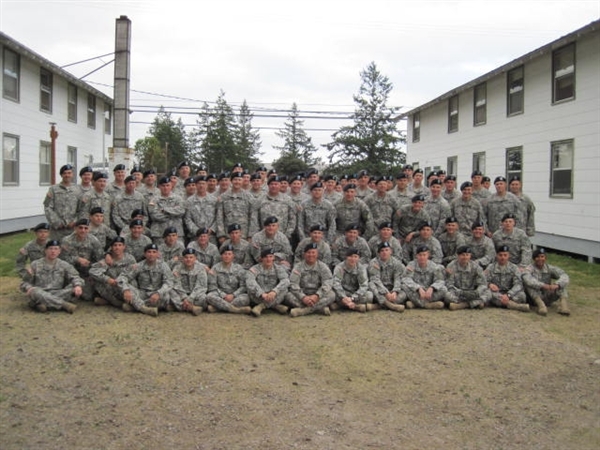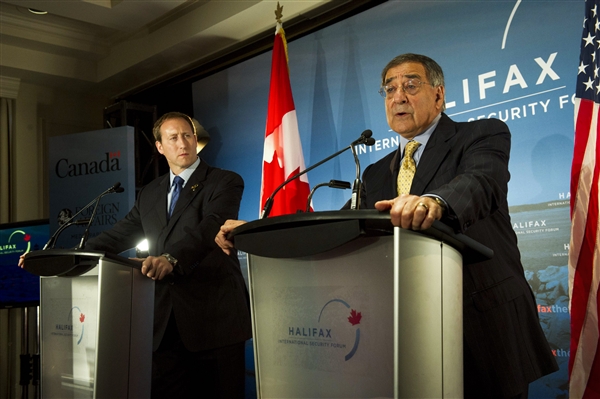WASHINGTON, Nov. 2, 2010 — On Sept. 2, 1945, Japanese Foreign Affairs Minister Mamoru Shigemitsu boarded the USS Missouri to sign the Japanese instrument of surrender, effectively ending fighting on the Pacific front in World War II.
Off the coast of Japan, the USS Oklahoma City was hunting for mines, clearing a path for the eventual occupation of Japan. Shortly thereafter, crewmembers of the Oklahoma City were among the first U.S. servicemembers to visit Hiroshima and Nagasaki after the cities had been destroyed by atomic bombs.
“The people were still bandaged up. Everything was just demolished,” Ray Palumbo said. “It was very emotional.”
Palumbo, Frank Zaccharo, Ralph Alfaro, Bill Crouch and Fred Kapanos all joined the Navy in 1944, serving together as the first crew of the Oklahoma City. Now all 84 years old, the five men looked back on their role in history with fondness and respect for their former enemies. The damage inflicted by the atom bomb is one seared into their memories.
“I wouldn’t say it was good, but it was a unique opportunity [to see Hiroshima],” Zaccharo said. “It’s something that’s still vivid in my memory.”
“It left a big, big impression on me,” Alfaro added.
By 1944, the war in the Pacific was in full swing. American forces were fighting in the Philippine and Palau islands and working to build airfields on Saipan, within B‑29 range of Tokyo. For years, Americans had been hearing about the wars in Europe and the Pacific, and many young men were chomping at the bit to get into the fight.
For some, being drafted into the Army at 18 was all the opportunity they needed. Alfaro said he had a different idea in mind as his 18th birthday approached.
“At that time, when you were 18, you got drafted right into the Army,” he said. “When I was 17, I decided I didn’t want to walk. I said to myself, ‘I gotta get into something where I don’t have to walk, [where] I can ride on something.’ So I joined the Navy. I couldn’t wait to get in. Patriotism was running through my blood.”
Over the previous three years, the images in newspapers and stories told in radio broadcasts hadn’t prepared the young sailors for what they’d see as they prepared to set sail across the Pacific Ocean.
“It wasn’t until we left Pearl Harbor in 1944 to head out to the Pacific when coming into Pearl Harbor was an aircraft carrier called the USS Franklin that had just been bombed by kamikaze planes,” Zaccharo said. “That was when I realized the reality of being in this war, and believe me, I was scared.”
The men said fear wasn’t a negative feeling. Rather, they explained, it helped them to understand the gravity of the situation. Kapanos said what servicemembers endure today is every bit as daunting as what he saw in the 1940s, if not more so.
“We salute the young people serving today. They’re doing their share of what needs to be done,” he said. “We can only give them a lot of credit and keep them in our prayers.”
The Oklahoma City supported the campaign in Okinawa and screened 3rd Fleet aircraft carriers during intensified air operations as Allied forces grew nearer to Japan.
The Oklahoma City crew was very fortunate to be part of the fleet arriving to accept Japan’s surrender, Crouch said. While so many in the world celebrated the Allied victory in the Pacific, he and his comrades got to experience the surrender first-hand and take part in the beginnings of subsequent American presence in Japan.
“The pride that we came out victorious, and to see our nation lead the world — that can’t be replaced,” Crouch said. “[We were] younger fellows at the time [who] shared our service to obtain that victory.”
The ship was relieved at the end of January 1946 and returned to the United States with its crew.
(“Veterans’ Reflections” is a collection of stories of men and women who served their country in World War II, the Korean War, the Vietnam War, operations Desert Shield and Desert Storm, and the present-day conflicts. They will be posted throughout November in honor of Veterans Day.)
Source:
U.S. Department of Defense
Office of the Assistant Secretary of Defense (Public Affairs)

 von
von 

